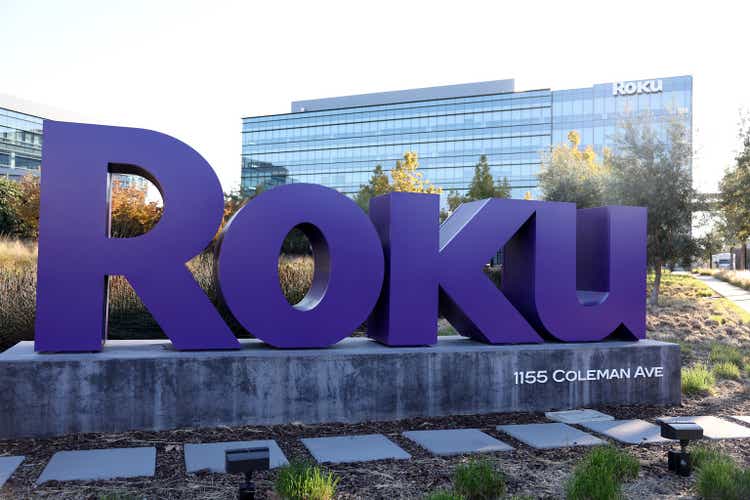Summary:
- Roku, Inc. stock has performed well after the company low-balled guidance ahead of the year.
- The TV broadcast and streaming markets are undergoing changes, making the future unpredictable.
- When taking into account stock comp, Roku stock’s valuation looks very high even on outer year numbers.
Justin Sullivan
Back in April, I wrote that while the numbers and trends for Roku, Inc. (NASDAQ:ROKU) looked poor, I was more neutral on the name, as I thought it had lowballed guidance. Since then, the stock has risen over 16%, while the S&P 500 (SP500) is up about 6%. Let’s catch up on the name.
Company Profile
As a refresher, ROKU is a TV streaming company whose operating system (“OS”) runs its own streaming devices, as well as those of several third-party TV makers. The company has also started offering its own TVs and other home electronic devices, including sound bars, video cameras, light bulbs, and video doorbells.
ROKU’s main business is its platform business. This segment includes the sale of subscriptions, video advertising in ad-supported channels, transaction-based content, billing services, and brand sponsorship & promotions. When consumers purchase a subscription to a streaming channel on its platform, ROKU generally gets of percentage of the sale through a revenue-sharing agreement. For ad-supported streaming services, it typically receives a portion of the ad inventory spots. The company also runs its own ad-supported streaming service, Roku Channel, and it owns an ad buying platform called OneView.
Stock Soars on Q2 Earnings
ROKU continued to set a low bar for itself that it can handily jump over. That proved the case once again in Q2, and the stock soared 25.4% the next session as a result.
The streaming company easily topped analyst revenue estimates by $72.5 million, or over 9%, to come in at $847.2 million, while its loss of -76 cents per share was 51 cents better than analyst expectations. Its adjusted EBITDA loss of -$17.8 million, meanwhile, was much better than its guidance calling for a loss of -$75 million.
ROKU’s Q2 beat, however, was much stronger than is Q1 earnings beat, which was solely powered by device sales. In Q2, the company saw its platform device revenue rise 9% to $103.4 million. Device gross margins were -17.0%, but that was a 300 basis point improvement over the prior year. However, it was a big decline from 3.4% in Q1, when they were helped by a $10 million service operator licensing catch-up fee.
ROKU’s platform numbers, meanwhile, were a mixed bag. Revenue rose 11% to $743.8 million, while ARPU dropped -7% year over year to $40.67. ARPU was flat sequentially.
Gross margins dipped -270 basis year over year and improved 60 basis points sequentially to 53.2%.
On its Q2 call, ROKU guided for Q3 revenue of $815 million, a gross profit of $355 million (margins of 43.6%), and adjusted EBITDA of -$50 million.
Discussing the current ad environment of its Q2 earnings call:
“I want to point out the good news amidst the industry-wide M&E pressure, and it’s that we’re building share versus the competition in M&E. I mean, advertising is still down in some verticals. As we noted, M&E tech and telco have been broadly actually reported on as down by the ad agency holding companies over the last few weeks. But as Anthony said, it will come back. We do all know that advertising is cyclical. But as an illustration of the M&E marketplace change that’s taken place in really less than 1 year, I was thinking about this, it feels like a long time ago, but in just August and September of last year, that’s when HBO Max, now Max launched its Game of Thrones spinoff. It’s when Amazon launched its Lord of the Rings, the Rings of Power TV show. And you’re not going to see anything like that this year for all sorts of obvious reasons. And so what a difference a year makes. But as Anthony noted, we’ve seen some of this coming, and we’ve been focused on ad diversification. We don’t want to be over reliant on any single vertical. So we continue to diversify and build new revenue sources and new ways to offer what were typically only M&E placements to non-M&E advertisers. So Roku City is a great example. We’ve introduced a new way for advertisers to connect with consumers, first with McDonald’s, which we spoke about at the new fronts and more recently, actually last weekend with the Barbie’s Roku City Dreamhouse. And these are just a few among several opportunities to integrate advertisers into Roku’s unique and broad reach virtual world, and it has remarkable potential. I’m really excited about it.”
Earlier this month, the company increased its guidance. It now expects Q3 revenue of between $835-875 million and adjusted EBITDA of between -$40 million to -$20 million.
At the same time, ROKU announced that it would lay off -10% of its workforce. It also announced that it will take a number of one-time charges. It will incur $45-65 million in severance costs, between $160-200 million in impairment charges related to exiting some office facilities, and another $55-65 million related to removing some existing licenses and produced content from company-operated services on its streaming planform.
The Media & Entertainment industry has always been the bread and butter of advertisers for ROKU, but that industry has been experiencing issues. Streamers have turned their focus more on profits than just growing subs, while the Hollywood writers’ strike has reduced the amount of content coming out. The latter issue looks like it could soon be resolved.
However, the company does appear to be drawing in a broader swath of verticals willing to advertise on its platform. The company has also been inventive, getting companies to advertise on its Roku City screensaver, which is dark-scrolling cityscape. Management deserves some credit for thinking outside of the box.
Valuation and Conclusion
Valuing ROKU isn’t easy, as the company currently isn’t profitable, although it has been in the past. The current consensus for the full-year 2023 is for ROKU to generate negative EBITDA of -$171.6 million, which is a marked improvement from earlier this year. The company also recorded nearly $360 million in stock-based compensation in 2022, which is a real expense that gets excluded in the EBITDA calculation. Stock comp was up nearly 19% to $186.1 million the first half, so this number does not appear getting smaller. Maybe with the layoffs it will start to shrink a bit.
If you want to go out to 2027, the analyst estimate is for the company to generate EBITDA of nearly $697.3 million. That places a value of the company of nearly 13x 2027 numbers. However, stock-based comp of say $400 million could wipe much of that away. Including stock comp, it would trade at a whopping 30x multiple, which isn’t cheap
Meanwhile, the entire TV broadcast and streaming market is pretty much in transformation, or perhaps even upheaval, right now. Cable operator Charter Communications (CHTR) was able to get powerhouse Disney (DIS) to drop carriage on five cable networks; offer more flexibility with packages; and be able to bundle cable with DIS streaming properties. Right now, there are too many broadcast and streaming channels in my view, so where everything pans out is still very much in the air, including where a middleman distributor like ROKU fits into the picture over the long run.
At this point, there isn’t enough clarity for me to get involved in Roku, Inc. The company set a low bar to start the year, and being able to fly past easy estimates has powered the stock. However, that’s not a catalyst that lasts indefinitely, and the valuation appears very high for company with pretty mediocre growth and metrics. As such, I remain neutral on Roku, Inc. stock.
Analyst’s Disclosure: I/we have no stock, option or similar derivative position in any of the companies mentioned, and no plans to initiate any such positions within the next 72 hours. I wrote this article myself, and it expresses my own opinions. I am not receiving compensation for it (other than from Seeking Alpha). I have no business relationship with any company whose stock is mentioned in this article.
Seeking Alpha’s Disclosure: Past performance is no guarantee of future results. No recommendation or advice is being given as to whether any investment is suitable for a particular investor. Any views or opinions expressed above may not reflect those of Seeking Alpha as a whole. Seeking Alpha is not a licensed securities dealer, broker or US investment adviser or investment bank. Our analysts are third party authors that include both professional investors and individual investors who may not be licensed or certified by any institute or regulatory body.

